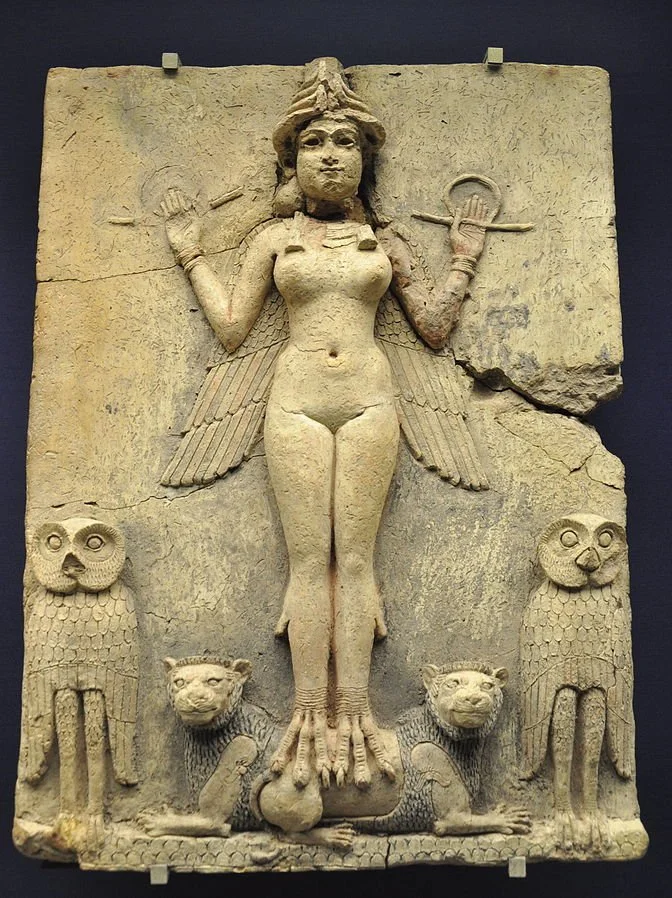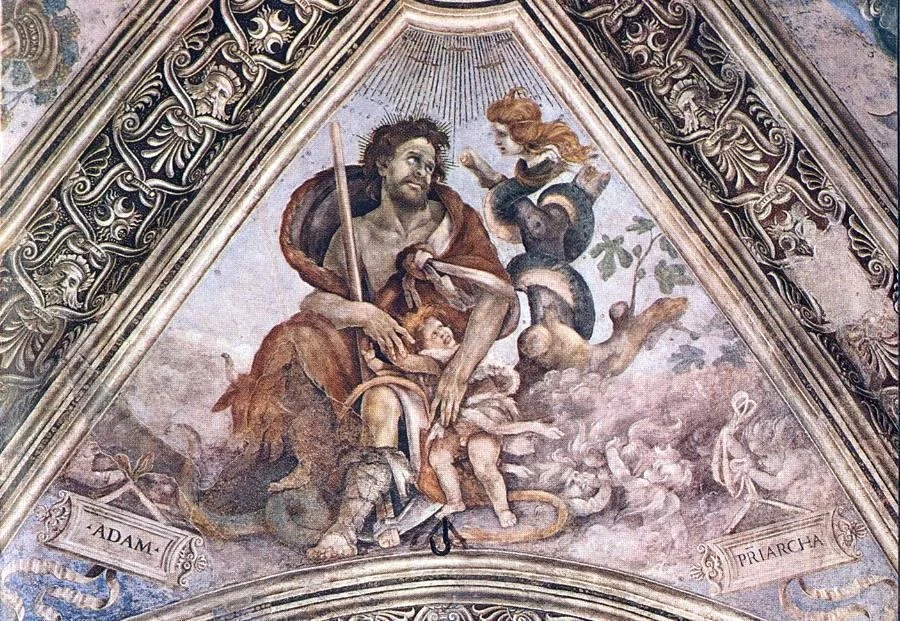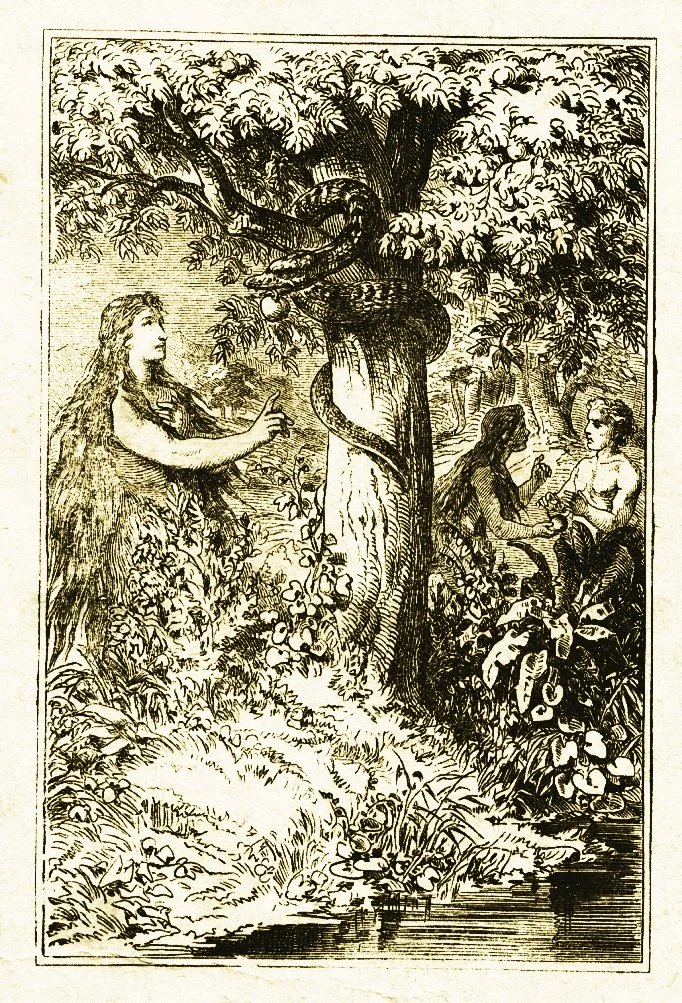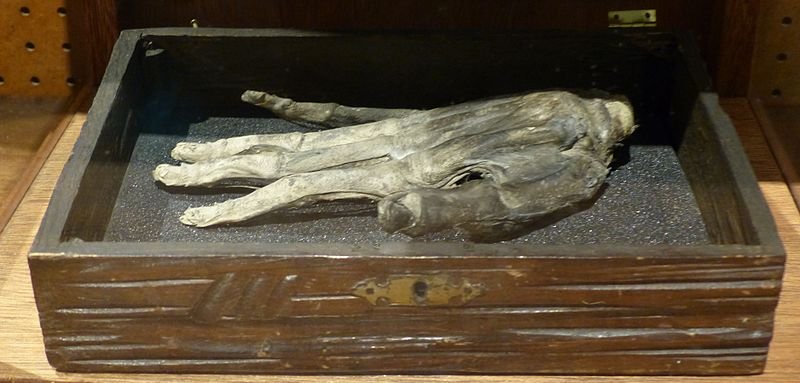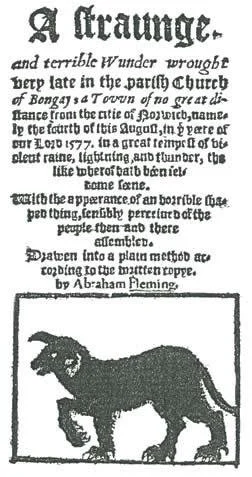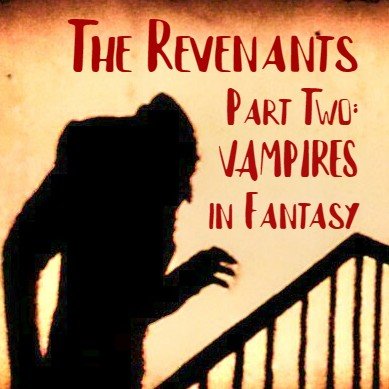Lilith, The Phantom Maiden (An Apocryphal Catechism)
In William Peter Blatty’s 1971 religious horror novel, The Exorcist, as well as the classic 1973 film based on the book, a demon named Pazuzu possesses a young girl and must be cast out by a stoic and dutiful Catholic priest. In the beginning of both the book and the film, the titular exorcist is present at an archaeological dig in Iraq, at which is uncovered a statue of Pazuzu, ancient Mesopotamian King of the lilu, or wind demons. This demon appears to be a chimera, with wings, bulging eyes on a canine face, feet like the talons of a bird of prey, and a serpent wound around his phallus and leg. A surface reading of the book or viewing of the film might cause one to think that the exorcist himself was ironically responsible for somehow freeing the demon by digging up the statue, but what was intended seems more like a portent of the imminent confrontation the exorcist will have with Pazuzu, whom he has struggled with before. However, it would seem that, maybe, Blatty chose poorly or researched only shallowly when deciding what Assyrian demon should be his antagonist. Pazuzu, in one aspect, was a domestic spirit of the home, and even in its more fearsome aspect, as depicted in the statue, was considered a protector. The lilu wind demons were considered evil spirits, it’s true, and Pazuzu chief among them, in that they were related to destructive winds and locusts that brought famine. But they weren’t associated with danger to youth. Quite the opposite. Pazuzu was called upon to drive off other demons. His statue was used as an apotropaic, an amulet, especially to protect the young from one particular demoness, Lamashtu. This she-demon, sometimes viewed as an evil goddess, was depicted much the same as Pazuzu, with talon feet and sometimes holding a snake, but hairier, without wings, and with the head of a lioness. According to Mesopotamian lore, she brought disease and nightmares, harmed women giving birth, abducted and slayed children, drank their blood, and chewed on their bones. Now there’s a villain Blatty might have made the torturer of a possessed child. But the lore of ancient Mesopotamian demons is all confused now. It has been combined and recombined with other folklore, evolving as the basis for new superstitions, incorporated into religion after religion, as the lines between what must have once seemed real figures have been syncretistically blurred. Here we see the protector become the ravager, but so too we see the evolution of Lamashtu, who eventually became identified with the lilu, her nature rewritten through the ages, reinvented by medieval Kabbalists who gave birth to an apocryphal legend.
As with my previous post on superstitions, this topic occurred to me rather organically while researching my Halloween series on vampire lore. Claims that lore about vampires extends all the way back to ancient myth are common. I looked into the assertions about links to Greek myth and the so-called “vampire bible,” the Delphi Scriptures, and found it utterly unconvincing and lacking support. I mentioned that at the end of my series. However, there are other prevalent claims that the lore and superstitions about vampires can be traced back to the figure of Lilith, and before her, Lamashtu. Unlike the supposed myth of Ambrogio, there is a lot of real history and folklore to unpack here, tangled up in syncretistic iterations, and I was not prepared to discuss its impact on vampire lore then. I am now. The connection seems clear enough. It is said that Lamashtu drank the blood of children. However, we know that the original vampire lore, deriving from claims about revenants, often had little to do with blood drinking. Also, to claim that Lilith was the prototypical vampire really doesn’t work, since she was known more for strangling that drinking blood, as we’ll see. Moreover, vampires are and always were the risen dead, humans transformed because of the circumstances of their death and burial, or due to the influence of the Devil. Their nature can be attributed to the various aspects of a decomposing corpse dug up by those who suspected its posthumous activity. In no way does this correspond to these spirits and deities, who were never human and appear as animal hybrids. Yes, I’ll get to the claims about Lilith’s human origin, but that’s irrelevant here, since according to her origin, as you’ll see, she was not a human, or undead. Moreover, revenants were never known to attack only children. The entire claim seems predicated on the detail about Lamashtu’s blood drinking, like someone went looking for the first ever thing thought to drink blood and then made the unsupportable assertion that there was some direct line of folkloric descent from that legend to vampires. A more logical but equally insupportable claim would be that the blood drinking aspect of vampires derived from other parasites known to suck blood, like leeches, or mosquitoes, which also spread disease like malaria, dengue fever, and yellow fever, though we didn’t know it back then. But on another level, there are some clear parallels between folklore and superstitions about vampires and those about Lamashtu and Lilith. As with revenants, Lamashtu was a scapegoat, blamed for the spreading of disease, likely blamed for sleep paralysis since she was thought to bring nightmares, and held responsible for any number of illnesses that might result in a child’s death or the death of a mother during childbirth. Lamashtu was even said to kill the unborn, so she appears to have been the scapegoat for stillbirth as well. It is clear that the figure of Lilith descended in some ways from the demoness Lamashtu, and it is clear that she too served as a scapegoat for a number of misfortunes, some similar and some quite different, but her myth took on ever more strange aspects, and she developed amazing importance in more than one religious tradition. So let’s begin with a look at the first real appearance of Lilith, not as a creature but a woman, the so-called “phantom maiden.”
A Pazuzu statue like the one shown in The Exorcist. Image credit: Lamiot (CC BY-SA 3.0)
I have spoken at some length, in my series on giants and my series on Flood Myths and Noah’s Ark, about the Epic of Gilgamesh. In case this is your first episode or you missed those others, the Epic of Gilgamesh is an ancient Mesopotamian epic poem that may have served as the source material for numerous biblical traditions. I spoke about the Flood Myth of Utnapishtim serving as the basis of the story of Noah, but additionally, there appear to be parallels and connections to the Genesis story of Adam and Eve in Eden. For example, the eating of the forbidden fruit appears to correspond to the Sumerian god Enki eating forbidden flowers and being cursed by his goddess wife, Ninḫursag, and dying. Each part of his body died, and when Ninḫursag relented in her curse, giving birth to goddesses who would each heal a part of Enki’s body, especial focus is given to his rib, and the goddess Nin-ti, or lady of the rib. Indeed, the Sumerian word for rib, ti, apparently also meant “to make live,” so Nin-ti meant both “the lady of the rib” and “the lady who makes live.” Some scholars believe that this ancient pun may be the origin for the part of the story of Genesis in which God makes a woman live from the rib of Adam. This aspect of the Genesis narrative will be very relevant to our discussion of Lilith later, but right now, what is more relevant, is the story of the Huluppu Tree, which some see as a parallel of or perhaps the origin of the story of the Tree of the Knowledge of Good and Evil, in which dwelled the Serpent. In the Epic of Gilgamesh, the goddess Inanna finds a primeval tree growing on the Euphrates River. In its roots, a snake or dragon nested, and in its uppermost branches, a massive, fire-breathing bird. Inanna wants to make a throne and bed of the tree, but these creatures stood in her way, and worse than they, in the trunk of the tree, so the poem states, Lilith, the phantom maiden, made her home. The word translated as Lilith here is Lillake, meaning ghost or phantom. In the Sumerian King List, an ancient chronicle kept to legitimize and delegitimize the reigns of various rulers, it is said that Gilgamesh, the basis of the poem who likely was a real king, was himself the son of a lilu demon. There is a strong sense among scholars that gradually, the monstrous she-demon Lamashtu and the evil lilu wind demons like Pazuzu, who were called lilitu in the feminine form, gradually came to be viewed as similar or the same. Such that the Lillake described in the Huluppu Tree was described as a ghostly young woman, a phantom maiden. Here is an inflection point in the development of the myth of Lillith. Gilgamesh drives the serpent from the tree roots, the great bird from its branches, and the phantom maiden from its trunk, and it is said that she flees from there into the wilderness or desert. It is there where we next find her.
Only once in all of the Bible is Lilith mentioned, and even then, the mention is dubious and demonstrates the nature of the figure as well as how she changed through the ages. In the book of Isaiah, chapter 34, verses 13 and 14, as the 8th century Israelite prophet, speaking of God’s judgment on nations and listing the many misfortunes that will befall a nation being divinely judged, talks of wild beasts and other creatures overrunning it: “Thorns shall grow over its strongholds, nettles and thistles in its fortresses. It shall be the haunt of jackals, an abode for ostriches. Wildcats shall meet with hyenas; goat-demons shall call to each other; there also Lilith shall repose and find a place to rest.” There is some debate about the historical context of the book of Isaiah, as well as its authorship, owing to changes in style and anachronisms that suggest everything after chapter 39 or 40 may have been written by a different, later author, but this chapter that makes mention of Lilith, quoted here in the New Revised Standard translation, is believed to represent the words of Proto-Isaiah, the prophet himself, who lived in the 8th century BCE in the Kingdom of Judah. A closer look at the original Hebrew and a comparison of the various translations may help us better understand this reference. The word lilit, taken in some translations as a proper name, is in other versions translated as night-spirit, night-monster, night-demon, night hag, night animals (plural), night bird, and screech owl. Some versions even change the name entirely to Lamia, an analogous child-eating female spirit from Greek myth who seems to be yet another iteration of the original Lilith figure, likely itself derived from the ancient Lamashtu. But this is a leap, for the Hebrew word being translated is lilit. I find the New Living Translation’s choice to refer to a plural, night creatures, as apt, since otherwise the verses in question are referring to plural beasts taking residence in the desolate nation. Remember that the original basis for the name Lilith seems to have been the plural word for Mesopotamian wind demons, lilu in the masculine, and lili or lilitu in the feminine. Thus the verse may not be referring to a singular figure, as many have believed, but rather a class of demons. Many translations view the previous creatures mentioned as goat demons, sometimes translated as satyrs; therefore, the verse would be describing both wild creatures and demons making the judged nation their abode. Other translations have it, however, that these verses are only describing wild creatures, specifically wild goats, and they translate lilit as a kind of bird, or specifically a screech owl. This seems questionable to me, since a few verses earlier, in verse 11, an entirely different word is widely translated as screech owl. However, the mythical Lilith, or particular female examples of the class of demons called lilitu, had long been associated with owls. One terracotta relief out of Babylon, the Burney Relief, has been discovered depicting her as a beautiful nude woman with wings and the feathered talon feet of an owl. And this image of her as a chimeric hybrid appears contemporaneous with the account in Isaiah, as on a 7th-century BCE tablet out of Syria, the Arslan Tash amulet, she is depicted as a kind of winged sphinx creature. Thus she may have been viewed as both a demoness and a wild creature, as she had previously been portrayed nesting in a tree in the Epic of Gilgamesh. Strange then that she would later be viewed as so human, less beastly and more beautiful.
The Burney Relief, depicting a monstrous Lilith. Image credit: Aiwok (CC BY-SA 3.0)
To make a clear and striking juxtaposition, Lilith today is viewed as a dark and beautiful woman with long hair. When we aren’t hearing about her as the progenitrix of vampires, she is thought to be the mother of all demons. Rather than originating as an offspring of a god, as did Pazuzu and Lamashtu, making her a kind of demigoddess, as were the demons from which her lore derives, she instead is claimed to have originated in Paradise, when the Judeo-Christian God created man and woman. She in fact is said to have been the first wife of Adam, formed from the dust just like him and therefore equal to him, not formed from a part of him like Adam’s second wife, Eve, and thus not subservient to him. Because of this aspect of her myth, she has become something of a feminist icon, representing an empowered and coequal gender, whom Adam rejects for not acquiescing to his domination. Thus Lilith, spurned but also defiant, sprouts wings and flies to freedom. In some depictions of her, like Pazuzu before her, she is associated with a serpent that winds itself around her, and as her myth developed, she became associated with the the figure of Satan. Some tellings have it that she returned to Eden to tempt Eve, whom she resented, with the forbidden fruit of the Tree of the Knowledge of Good and Evil. Thus we see again Lilith nesting in the tree in paradise, as in the Epic of Gilgamesh. Other versions focus on her insatiable sexual appetite and after her fall make of her more of a succubus demon who returns to Adam to have intercourse with him, and from her unholy unions with Adam as well as with other men, she conceives and gives birth to other demons, an entire race of succubi and incubi, called lilin, and so once again we return in a roundabout fashion to the notion that Lilith is not unique but rather one of an entire race of demons with similar attributes and behavior. But how did we get from the notion of Lilith as the later version of Lamashtu, a wild, animalistic demoness, part bird, who devours children, to the notion that she was one of God first creations, made in his image in Paradise? The answer is that it was invented, whole cloth, during the Middle Ages in an apocryphal work of Aramaic and Hebrew proverbs.
The Alphabet of Ben Sira is believed to have been composed anonymously between 700 and 1000 CE. The work was clearly inspired by a Hebrew collection of ethical lessons written in Jerusalem in the 2nd century BCE by one Ben Sira, but scholars believe the medieval work to be more of a satire. The author likes to address topics such as sexual intercourse, masturbation, urination, and flatulence. In fact, fair warning, any discussion of this composition, as well as certain aspects of Lilith, will get a bit bawdy and weird. It has been suggested that the Alphabet of Ben Sira may have actually been written by a Jew as a kind of burlesque comedy poking fun at his own traditions, or by a non-Jew as a kind of mockery of Judaism. One example of the parodic nature of the work is that its protagonist, Ben Sira, is said to be the grandson of the prophet Jeremiah, whom God had commanded not to marry or have children. Well, according to the Alphabet of Ben Sira, Jeremiah did have a partner, and had a daughter with her, but in an effort to obey God’s command, would apparently practice Onanism, or coitus interruptus—which, at the risk of being crude, is basically pulling out to spill one’s seed. According to the author, the prophet Jeremiah did this once in bathwater that his daughter afterward bathed in, resulting in his impregnating his own daughter, making Ben Sira both the grandson and son of the prophet Jeremiah. One can see why this work is apocryphal and rejected even back in the Middle Ages by Jewish philosophers and rabbis. The passage in which the author invents the modern legend of Lilith occurs when King Nebuchadnezzar asks Ben Sira to heal his son, and Ben Sira blames Lilith for the boy’s illness and makes an amulet for his protection. He then explains who Lilith is to Nebuchadnezzar, saying God created her for Adam so that Adam wouldn’t be alone and made her out of earth just as He had made Adam. However, they began to argue over sexual positions, with Lilith refusing to be on the bottom, and Adam insisting that he was superior and therefore must be on top. Lilith protests that they are, in fact, equal, being made from the same stuff, and when Adam denies it, she abandons him, sprouting wings and flying away to the sea. Adam, of course, complains to God that his woman has run off, so God sends angels to bring her back. Lilith, however, refuses to return and claims she “was created only to cause sickness to infants.” The story concludes with Ben Sira explaining that, because of the deal she struck with the angels sent after her, the amulet he had made would be effective at driving her off. The story further indicates that she is the mother of demons, many of whom are doomed to perish every day. The tale given in the Alphabet of Ben Sira is the first known suggestion of her creation in Eden as Adam’s wife, but the notion of her as a bringer of misfortune to children, which is also present, was likely inherited from her forerunner, Lamashtu. How she came to be known as the mother of demons is not especially clear, but it would come to define her persona.
Adam clutches a child in the presence of the child-snatcher Lilith.
The next development of the Lilith myth came in another medieval Jewish text, the Zohar. This work was said to have been composed actually long before the Alphabet of Ben Sira, in the 2nd century CE, supposedly by the famed sage Rashbi, or Shimon ben Yochai, but this claim appears to only have been made by the man who first promoted the text, Moshe ben Shemtov, or Moses de León, a Spanish rabbi and Kabbalist, a kind of traditional mystic. The problem is that Moses de León was known to compose pseudepigraphal Kabbalistic tracts, meaning he falsely attributed his writings to other, typically ancient and more authoritative sources, which increased their value. In other words, he was a forger. Indeed, de León’s widow, according to one report, explicitly revealed the Moses de León wrote the Zohar himself in the 13th century and attached Rashbi’s name to it in order to make it more valuable. Nevetheless, within fifty years, it was considered a core sacred text among many Spanish Kabbalists. Regardless of the authorship controversy, the book purports to be a collection of the teachings of the sage Rashbi, as well as commentaries on the Torah and allegorical narratives. In it, Lilith is discussed some sixty times, and in other Kabbalistic writings, her myth is further expanded. The notion that she was created of dust the same as Adam is reinforced, but in some Kabbalistic works, it is claimed that, for some unclear reason, when God made Lilith he formed her not of good, clean dust or soil, but rather of unclean filth. The idea that she fled Paradise after a quarrel with Adam remains. However, in the Zohar, we learn that Adam actually impregnated Lilith before she fled, and that when she bears his children, they are demons or spirits, thus clarifying Lilith’s role as a mother of demons. A further aspect clarified is her perpetual yearning for male companionship, such that when she fled from Paradise, at one point she found herself near God’s throne, which was surrounded by Cherubim, and since cherubs looked like little boys, she attached herself to them. But it was Adam she longed for, and Kabbalist tradition tells us she returned to the garden, but finding Eve with him, she schemed to be rid of her by tempting her, thereby contributing to Adam’s Fall as well. But Kabbalist tradition is far more intricate than this. Kabbalist mystics actually rewrote much of the origin story of Lilith, suggesting that rather than a creation of God she was a spontaneously generated divine creature, a kind of manifested aspect of God, an emanation from beneath his throne, which kind of sounds like a fart to me. By this alternative version, she was only part of an androgynous, dual entity, Lilith being the female half and Samael, a rebel angel and adversary to God identified with Satan, was her male counterpart. Thus, Lilith and the Devil were one and the same, so she was the Serpent in the Garden just as much as he was. Despite this development of Kabbalistic lore that has Lilith being more of a demoness from the start, she is always depicted as longing for Adam and for the company of all men. After the Fall, she copulates with Cain, bearing many demons. And Adam, upon finding out that their expulsion from Paradise and the murder of his son may have had to do with his connubial relationship to Lilith, decides to be celibate and not even lie with Eve for a whopping 130 years. However, during these many years, it’s said that Lilith comes to Adam in his sleep, stealing his seed, and begetting many demons, an entire demonic race, in fact: the Lilin, a plague upon mankind that are said to lurk in dark places, such as doorways and wells and in pits used as latrines. Thus, in the Middle ages, a tale that likely began as satire was expanded upon by forgers and mystics into the full-fledged myth of a separately created woman, a nymphomaniac spirit who caused the fall of man and became a succubus that mothered an army of demons.
A simple explanation for the popularity of this growing and changing myth is that, much like her folkloric precursor, Lamashtu, Lilith served as a useful scapegoat and superstitious explanation for a variety of misfortunes and embarrassing or baffling experiences. While the philosophers and mystics spoke of her origin and nature, the everyday people only feared her and blamed her for things. Her nature as a succubus who stole the seed of men to give birth to demons meant that Lilith was commonly believed to be the cause of nocturnal emissions. Whenever a male had a wet dream, it was said that Lilith had come to him in his dreams and succeeded in arousing him to the point of impregnating her. Perhaps the men or boys who had these nocturnal emissions and were embarrassed by them or confused were consoled by this superstition. Men also likely claimed to their wives that they had better engage in frequent intercourse with them or it would be their fault when Lilith came to them, and it was thought that when Lilith succeeded in seducing a man, she gained some rights of cohabitation in the household. Thus later artifacts that bear the name of Lilith, like incantation bowls and other charms, are inscribed as literal writs of divorce, declaring that Lilith had no rights there. The danger was even thought to exist when a man slept with his wife, whether he spilled his seed outside of her on purpose, if you’ll excuse the frankness of my remarks, or even if some of his semen was lost accidentally. Lilith was thought to lurk in the bedsheets, waiting to steal it, and rather comically, men would shout out at the moment of orgasm, “Release, release! Neither come nor go! The seed is not yours!” Nor were men alone the supposed victims of Lilith or her other succubi children, for some of her demon offspring were male incubi and were said to visit women in their sleep and impregnate them. Of course, one can easily imagine this scapegoat being quite handy if a woman needed to explain a seemingly inexplicable pregnancy. And it must also have been used as a defense by rapists, who could easily blame a woman’s violation on some incubus. But this idea of the incubus seducing or assaulting women in dreams returns us to the notion of sleep paralysis and the “incubus phenomenon,” the sleep disorder in which one feels pressure on them and even has a vision of a dark figure or night hag—the origin of the word nightmare. So Lilith and her brood can be seen as a superstitious explanation of those hypnopompic hallucinations, another parallel with revenants or vampires. And also like revenants, they were blamed for inexplicable deaths or illnesses. It was said that Lilith attacked pregnant women because of her resentment of Eve and her partnership with Adam. Thus when a woman died in childbirth or afterward, from the all too common childbed fever, it was said Lilith had taken her. Likewise, Lilith, like her antecedent Lamashtu, was said to prey upon children, blamed for stillbirths and miscarriage, and was also blamed when children died in infancy. She was sometimes said to drink their blood, which aspect had likely been carried down through the centuries from superstitions about Lamashtu, but mostly she was said to strangle babies in their cradles. As one might imagine, then, Lilith took the blame when the terrible and seemingly incomprehensible tragedy of crib death, or what we might today call Sudden Infant Death Syndrome, occurred. Indeed, even adults who died in their sleep were said to have been taken by Lilith or her Lilin; it was said that after a succubus or incubus demon successfully seduced someone, they might change form and kill them. Thus, Lilith evolved to become a kind of catch-all superstition, a scapegoat for most mysterious phenomena related to sleep, maternity, and infancy.
Illustration of Lilith’s involvement in the temptation of Eve and Adam in the Garden of Eden.
As we have seen, through syncretism, dubious satirical texts, pseudepigraphal forgeries, and mystical apocrypha, the myth of Lilith grew through the ages. But how, some may rightly ask, could an orthodox believer, a modern Christian or Jew who credits only canonical scriptures, ever come to believe in the figure of Lilith when she is only explicitly mentioned in Isaiah and even then only in some versions? The answer comes in a unique interpretation of the Genesis Creation story. The book of Genesis actually appears to have two versions of the story of God’s creation of mankind, in chapters 1 and 2. In chapter 1 verse 26, it says, “Then God said, ‘Let us make humans in our image, according to our likeness…’” and concludes in the next verse, which states, “So God created humans in his image, in the image of God he created them, male and female he created them.” Then in chapter 2, it tells a slightly different version of the story, having God make man first, saying in verse 7 “then the Lord God formed man from the dust of the ground and breathed into his nostrils the breath of life, and the man became a living being.” Only later, beginning in verse 18, is woman created: “Then the Lord God said, ‘It is not good that the man should be alone; I will make him a helper as his partner’… then he took one of his ribs and closed up its place with flesh. And the rib that the Lord God had taken from the man he made into a woman and brought her to the man.” This double telling of the story is easily explained if one views Genesis as a combination of traditional texts which vary in their particulars. After all, Chapters 1 and 2 have distinctly different styles, present the events of Creation in a different order, and even use different words for God. The orthodox view of the separate accounts is just that Chapter 1 represents a larger overview of the cosmological events of Creation and Chapter 2 zooms in for a more human focus. But if one is wanting to find evidence of Lilith in Genesis, one will certainly be inclined to view the first Creation story as being the Creation of Adam and Lilith, and the second as being an explanation of the reason for Eve’s later creation. When God says it’s not good for man to be alone, it must be because Lilith has fled from Adam, for God is omniscient and must have known such things even before Creation. It’s an interesting interpretation, but one can creatively interpret scripture in many such ways to find evidence of things that aren’t there. Consider the “Gap Theory” or gap creationism. To reconcile the Genesis story of Creation with the geological time scale, theologians have suggested that each day of creation actually represented an entire age, whereas others have said that some extended gap occurred between the creation of the heavens and earth in verse one and the rest of the creative acts that are listed starting in verse two. Such an interpretation allows believers to trust in a literal interpretation of the Bible without denying many of the findings of modern science, such as the age of the earth, and the fossil record, dinosaurs, etc. However, it has also led some to believe that, since there was a first creation, and later a second creation that included mankind, that there must have existed some first attempt at creating humans, a so-called “pre-Adamic” race. Unsurprisingly, in the 19th century, this notion was latched onto by racists looking for some religious support for their ideas that non-white people are inferior, suggesting they are the descendants of a separate Creation, a failed dry run at humanity. All of this from literally reading between the lines, a mythos of hatred born from the blank space between the first two verses in Genesis. We see how these ideas spread and evolve, and how they are used to justify superstition and false beliefs. The development of the apocryphal myth of Lilith is much the same, syncretistically adapted from ancient pagan folklore, fictionalized and expanded on through the inventions and interpretations of charlatans and mystics, until even modern theologians find arcane reasons to credit it because they want to. It seems like it should be enough to cause any honest critical thinker to lose faith in such claims and interpretations.
*
Until next time, remember, ancient texts are often a mish mash, a collage of pieced together traditions, compilations of copied manuscripts, a palimpsest through which can be discerned traces of previous writings and ideas, often falsely attributed to some famous figure when they were actually composed by some faceless scribe. Can’t we just appreciate them for what they are, a priceless cultural artifact that teaches us about our past, without insisting they’re actually some monolithic divine pronouncement?
Further Reading
Blasdell, Heather L. “‘...And There Shall The Lilith Repose.’” Mythlore, vol. 14, no. 4 (54), 1988, pp. 4–12. JSTOR, http://www.jstor.org/stable/26812954. Accessed 21 Nov. 2022.
Kramer, Samuel N., and W. F. Albright. “Enki and Ninḫursag: A Sumerian ‘Paradise’ Myth.” Bulletin of the American Schools of Oriental Research. Supplementary Studies, no. 1, 1945, pp. 1–40. JSTOR, https://doi.org/10.2307/20062705. Accessed 21 Nov. 2022.
Patai, Raphael. “Lilith.” The Journal of American Folklore, vol. 77, no. 306, 1964, pp. 295–314. JSTOR, https://doi.org/10.2307/537379. Accessed 21 Nov. 2022.
Soza, Joel R. Lucifer, Leviathan, Lilith, and Other Mysterious Creatures of the Bible. Hamilton Books, 2017.



